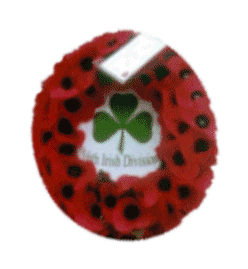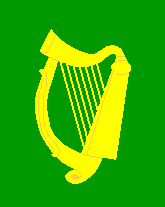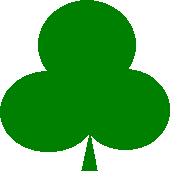
The wreath laid by Yvonne McEwen,
granddaughter of Sgt Patrick Doherty,
at the commemoration in June 2001
of the Combined Irish Regiments

The wreath laid by Yvonne McEwen,
granddaughter of Sgt Patrick Doherty,
at the commemoration in June 2001
of the Combined Irish Regiments
| This website is to honour the men of the 16th Irish Division who took part in the Great War of 1914-1918. These brave and dutiful soldiers are little remembered because the Ireland from which they enlisted to fight for the freedom of small nations had, by 1918, undergone a sea-change in national aspirations. This Irish Division vanished into limbo, without honour, lying in an unquiet grave. |
|
ORIGIN OF THE
16TH IRISH DIVISION |
||
|
Following the outbreak of war in Europe in 1914, the small British land forces, at that time established for colonial and home defence duties, had to be rapidly expanded. Lord Kitchener's call for volunteers, made to a receptive audience in most parts of the British Empire, was answered by thousands.These enthusiasts would form Kitchener's New Army.Kitchener's thirty New Army divisions would supplement the six divisions of Regulars and the fourteen of Territorials. The first six New Army divisions were geographically-based, e.g. 9th(Scottish), 10th(Irish), 12th(Eastern). The raising of the 10th(Irish) Division was in accordance with the well-established practice of recruitment of Irishmen to fight in the British Army. There had been Irish Regiments in the British Army from the late 1600s. Kitchener's Army was to have 360 battalions. The new battalions would be allocated to existing regiments and known as Service Battalions. The established Irish Regiments of the Line were: The Royal Inniskilling Fusiliers Initial recruitment to the 10th(Irish) Division Service Battalions of the Irish regiments was considerably below the numbers joining English, Scottish and Welsh regiments. Although recruitment to the Ulster-based 6th Battalion Royal Irish Rifles was satisfactory, by the end of August 1914 the numbers joining the other two Ulster-based regiments, the Royal Inniskilling Fusiliers and the Royal Irish Fusiliers, had not reached 20% of that required. The reason for the lack of enthusiasm in Ulster lay partly in the political situation in Ireland that had reached an explosive crisis point in the summer of 1914. This situation had threatened to bring the British Army into action in order to suppress the protestant Ulster Volunteer Force. The rebellious antagonism of this 85,000 strongprivate army to the re-introduction of an Parliament for the whole of Ireland in Dublin, an antagonism reflected in and supported by the opposition Unionist(Tory) Party at Westminster, and many Army officers, made its well-armed, by gun-running from Germany in April, and well-organised members determined not to be marched away to a European warand leave Ulster to be governed internally from Dublin. The UVF's political leader was Sir Edward Carson MP. An opposing private army had been formed in the south of Ireland. This was the Irish Volunteers. Much less politically-homogenous than the UVF, the Irish Volunteers included those whose sought a constitutional solution under the British Crown, 'Home Rule', and those who wanted an independent Irish Republic. Although at 180,000 the Irish Volunteers were more numerous than the UVF, they were poorly-armed and generally untrained. In late July, an attempt to land arms from Germany, just like the UVF, resulted in British troops killing several unarmed civilians in Dublin. John Redmond MP, a Irish Party constitutionalist, was the nominal political leader of the Irish Volunteers. |
||
|
July 1914: Redmond presents a colour to the Maryborough Volunteers |
||
| For many weary years Home Rule or 'The Irish
Question' had bedevilled the British Parliament. The Union of 1801 that
had abolished the Irish Parliament was despised by the Roman Catholic Irish.
It had not saved Ireland from appalling misery, death and depopulation in
the famines of the mid-nineteenth century. It had refused Catholics the
same voting rights as many protestants and denied them many basic human
dignities. However, Irish agitation throughout the nineteenth century and
into the twentieth had secured the final passage of a Home Rule Bill in
May 1914. Only the Royal Assent was needed to make it law.
It was during the expectation of Civil War in Ireland that the powers of Europe entered the sequence of action and counter-action that was to lead inexorably to the Great War. For Britain the causus bellum for her declaration of war on 4th August was the German invasion of Belgium. For Britain the 'freedom of small nations' was of overriding concern, a sentiment that all the Irish Volunteers shared. The immediate effect of the declaration of war was the eclipse of the Irish problem. Overnight the Liberal Government, its political allies, and the Opposition Unionists were united. The smouldering tinderbox of sectarian Ireland was extinguished by the certainty of a much greater international conflagration.Amongst the Government's allies was the Irish Party led by John Redmond. Crucially he agreed with Prime Minister Asquith that the implementation of Home Rule should be put off for the duration of the war, or one year, whichever was the longer. Sir Edward Carson agreed not to introduce an amendment to maintain the union in respect of six mainly-protestant counties of nine-county Ulster. No-one, except Kitchener, expected the war to last as long as a year. Even before the declaration of war both Redmond and Carson had promised support for the British war effort. Redmond had been acutely conscious of public opinion in respect of Home Rule. But neither Redmond or Carson initially intended that their Volunteers should join up to fight in Europe. Their offers had been to protect Ireland and thereby release regulars for France or elsewhere. At separate meetings with Kitchener in early August neither Redmond or Carson had not been able to persuade the War Director to incorporate their Volunteersinto the structure of the British Army. Redmond continued to hold out for wholesale incorporation of the Irish Volunteers as a defensive force. But by late September Carson had been authorised to recruit men for a New Army Division to be known as the 36th(Ulster) Division. The facility with which the 36th(Ulster) Division recruited throughout Ireland reflected very much on the empathy between these erstwhile rebels and the officer corps of the British Army. The division required all recruits to sign the Solemn League and Covenant that pledged opposition to Home Rule in Ulster. It was pleased to be recognised as the Orange Division because of the inseparable association of the UVF and the Orange Order, a militant anti-Catholic organisation. It was the first British military formation since the English Civil War to have an overt political credo. Redmond still pressed for a distinctly Irish Brigade. He could see that Australia, New Zealand, Canada and South Africa, each autonomous within the British Empire, were preparing to contribute their own military units. Why could not Ireland, with the Royal Assent about to be given to the Home Rule Bill, be regarded as an equivalent source of men? Unfortunately for Redmond, for Britain and for Ireland, the man to whom he had to address that question was the supreme War Lord, Horatio Herbert Kitchener. |
||
|
"Not a great man - but a great poster": Anon |
||
| Kitchener was paramount in the British military.
He had first achieved fame by his defeat of the primitive Mahdist forces
at the Battle of Omdurman in 1898. His scorched earth policy and his introduction
of concentration camps for civilians finally secured victory for Britain
in the second Boer War. He was appointed War Secretary in 1914 and immediately
began a highly-effective recruiting campaign in Britain for his New Army.
Kitchener was dogmatic to an extreme. He typified many of the characteristics of the British governing class that were detested by the Irish. Not the least of these was his self-conviction that no-one could tell him anything about the Irish Problem. He had indeed been born in Ireland and had been brought up an overbearing and cruel soldier father before being sent to Switzerland to be educated. It was to this autocrat that Redmond made his request for a distinctly-Irish unit to be created. Kitchener continued to turn Redmond down. Private armies, and Irish ones at that, were anathema to him. He was not impressed by the Home Rule Bill. This rejection was a great blow to Irish aspirations, not to mention pride. It was the first of many British blows that, in the end, were as fatal to the longevity of the 16th(Irish) division as were German bullets. Recruitment to the 10th(Irish) Division had picked up but the creation of second Irish Division still seemed doubtful. Many Irish recruits were choosing non-infantry units and corps; the Army Cyclists Corps was popular. Some, even well-known Nationalists, were enlisting in the Regular battalions rather than the new Service battalions. In September, with the 36th Division now recruiting strongly, Redmond was now approached for assistance in the recruiting effort for the 16th. One of its three Brigades, the 47th, consisting of four Service Battalions, would be specifically intended to receive members of the Irish Volunteers. Hitherto Redmond had not been prepared to accept that the Volunteers would be liable for overseas service. He came under increasing pressure from the British military to alter this view. He was told that no Volunteers would be accepted if they were not prepared to serve abroad. The Royal Assent to Home Rule was given on 18th September. The news was greeted with excitement in Catholic Ireland. Two days later, Redmond, speaking near Woodenbridge in Co Wicklow, implicitly encouraged the Irish Volunteers to fight abroad in the cause of a small nation, Belgium, struggling, like themselves, to be free.
|
||
|
John Redmond addresses a recruitment
meeting in Wexford. |
||
| Redmond had been caught between a rock and a
hard place. If he did not encourage his followers to support the British
war effort, they stood to lose the Home Rule Act. Another argument for enlistment
was that it would be to the Irish Volunteers' advantage to become as well-trained
and experienced as their potential foes, now joining the 36th(Ulster) Division.
Notwithstanding that pragmatism, Redmond fervently hoped that the great
dangers to be shared with the 36th would reconcile the Irish factions and
lead to a united Ireland. Many Catholic Irishmen, from North and South,
amongst them thousands of National Volunteers, followed Redmond's call and
enlisted in the 16th(Irish) Division.
The Irish Volunteers, a broad front, split. The Redmondites became known as the National Volunteer Force. The title 'Irish Volunteers' remained with those who would rather fight against the British than for them. Although they did not yet know it, the Redmondites, by their adherence to the cause of the British Empire, had marched off the stage of Irish politics for ever and left it to the hard-liners. They applauded this exit; they would put on their own show soon enough. |
||
|
Sources:
War Memoirs of David Lloyd George, 1938, Odhams Ireland's Unknown Soldiers, Terence Denman, 1992, Irish Academic Press The "Miracle" of Ireland, John Redmond, 1916, Amalgamated Press |
||
|
"The Unquiet Grave" |
|
WEB-PAGES FROM THE
16TH IRISH DIVISION SCRAPBOOK |
||
 |
 |
|
|
Guillemont
including trench map and Ginchy
|
||
| Lt A E S Barton of the RFC, who was shot down during the Battle of Langemarck. | ||
The number of visitors to this page since 1st April 1999
is: